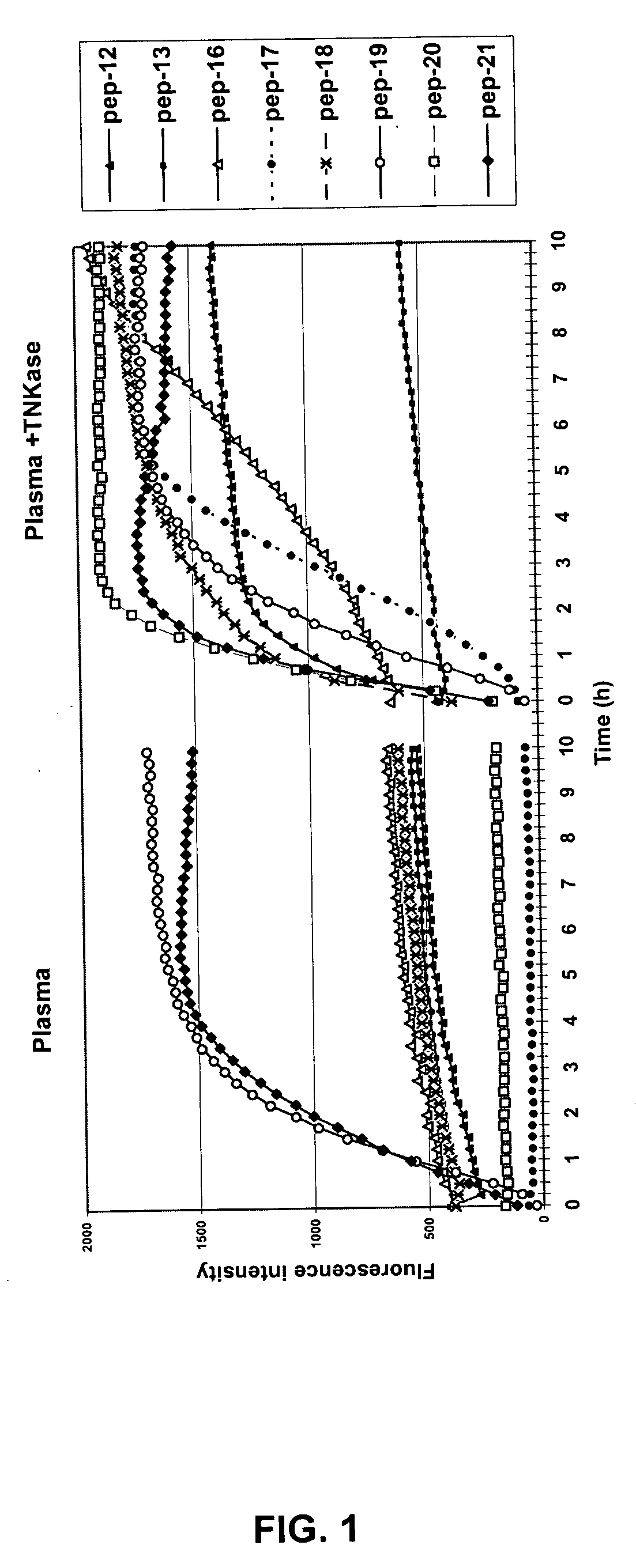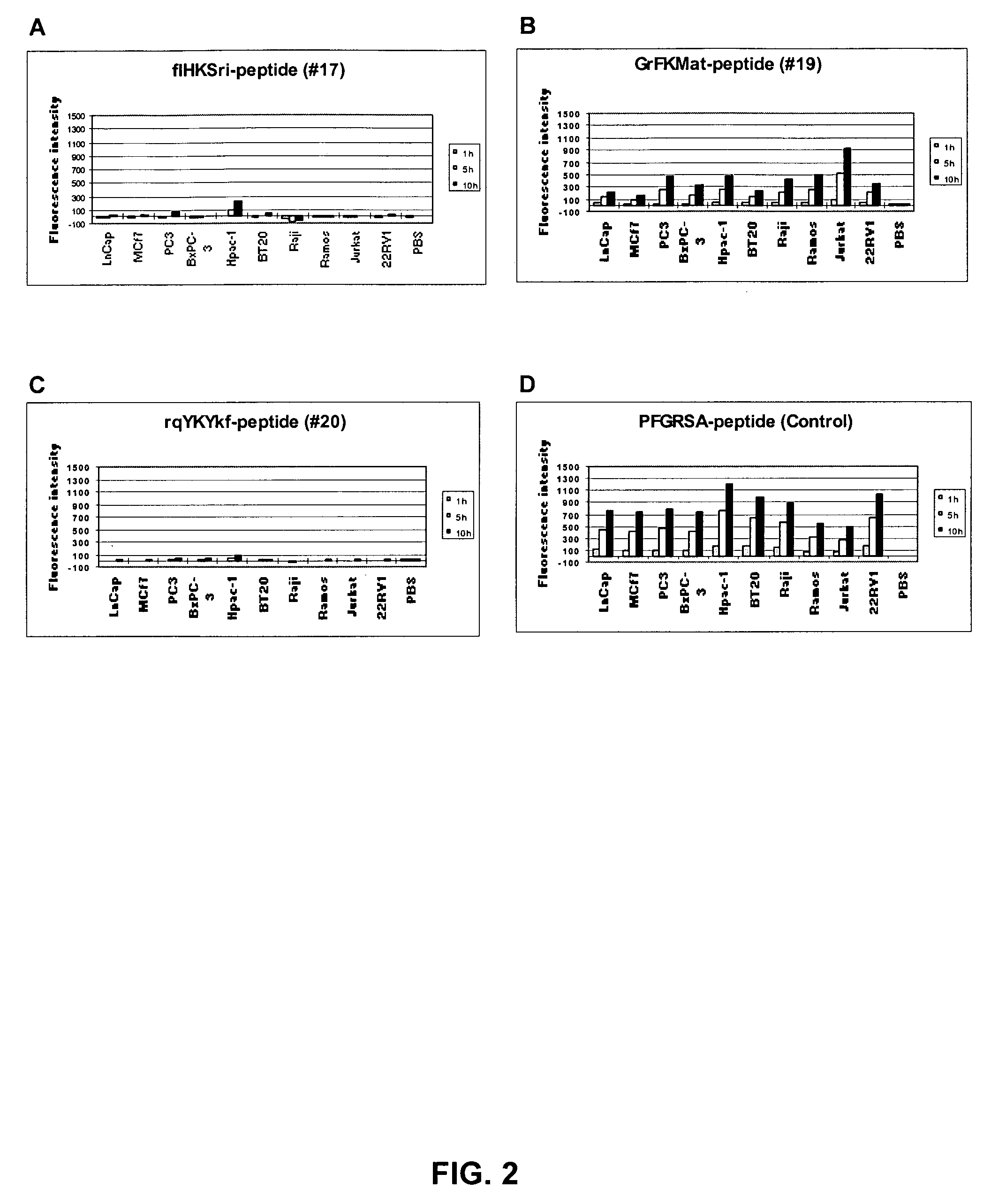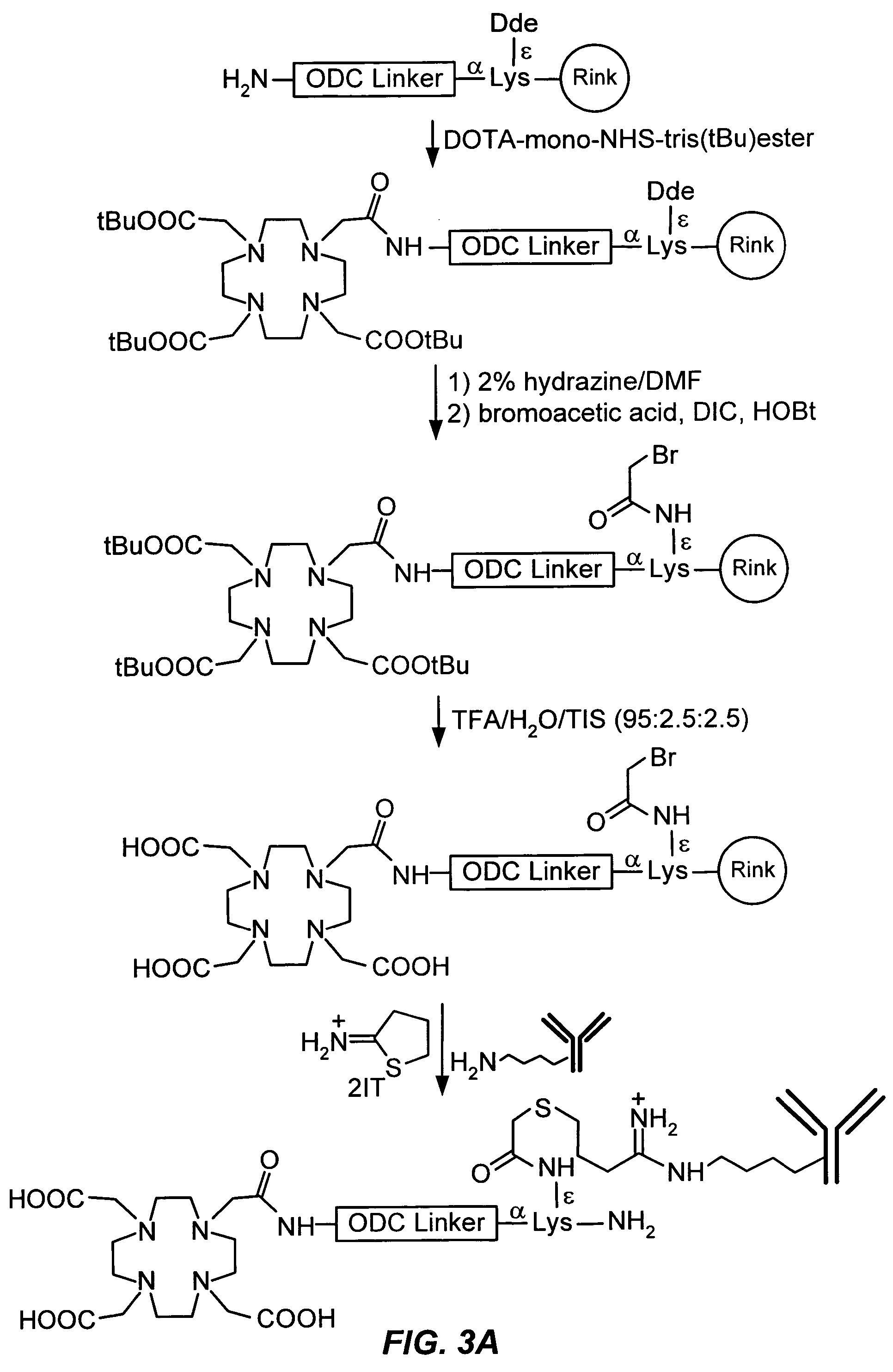On-demand cleavable linkers for radioconjugates for cancer imaging and therapy
a radioconjugate and linker technology, applied in the field of on-demand cleavage linkers for radioconjugates for cancer imaging and therapy, can solve the problems of severe drawbacks and limitations of immunophoresis in clearing free circulating rics after adequate tumor uptake, liver toxicity is also a dose-limiting factor, etc., to improve site-specific delivery of biological agents and enhance removal of those agents
- Summary
- Abstract
- Description
- Claims
- Application Information
AI Technical Summary
Benefits of technology
Problems solved by technology
Method used
Image
Examples
example 1
Synthesis of OBOC Combinatorial Libraries
[0177] Random synthetic combinatorial libraries are synthesized by a “split synthesis approach” as previously described (Lam et al., Nature, 354:82-84 (1991); Houghton et al., Nature, 354:84-86 (1991); Furka et al., Int. J. Peptide Protein Res., 37:487-493 (1991)). Amino-PEGA beads with a substitution of 0.4 mmol / g and diameter of 100-150 μm are used as solid phase support (Novabiochem). Amino-PEGA resin (1 g) is swollen in 15 ml DMF overnight and washed with DMF twice. A solution of Fmoc-(L)-Lys(F-Boc)-OH (0.562 g, 1.2 mmol), HOBt (0.162 g, 1.2 mmol), and DIC (188 μl, 1.2 mmol) in 10 ml DMF is added to the resin. The mixture is agitated at room temperature for 1 h. Complete coupling is confirmed by ninhydrin test. The resin is then washed with DMF (10 ml×3), MeOH (10 ml×3), and DCM (10 ml×3). The ε-Boc group of Fmoc-(L)-Lys(ε-Boc)-PEGA is removed with 50% TFA / DCM (twice, 10 ml and 10 min. for each time). The resin is immediately washed with...
example 2
Screening OBOC Combinatorial Libraries for Protease Substrates
[0180] Peptide libraries are prescreened with human plasma and tumor cell culture supernatants so that all peptides which are susceptible to cleavage by proteases present in the plasma or at the tumor site are eliminated prior to screening with a protease. Preferably, the protease is a modified form of t-PA such as Activase® and TNKase®. About 1 ml of beads (equivalent to approximately 400,000 beads) are used in each screening experiment. The peptide bead library is first washed 5×with phosphate buffered saline (PBS), pH 7.2, in a small polypropylene column (2 ml). 200 μl of freshly thawed human plasma and a mixture of tumor cell line culture supernatants are then added and incubated at 37° C. for 1.5 hr. After washing with PBS, the beads are transferred to small Petri dishes and inspected under an inverted fluorescent microscope (OLYMPUS 1X70) with a U-M620 (330-385 nm) filter. All of the blue fluorescent beads are care...
example 3
Evaluation of Susceptibility of Peptide Linkers to Proteolysis: Specificity, Km, and Vmax.
[0186] Positive peptide substrates are resynthesized to confirm their specificities by determining the cleavage of these peptides by tumor cell supernatants, human plasma, purified tPA (Activase®, TNKase®), and urokinase using a solution phase assay. Urokinase is known to be present in some tumors and could potentially cleave the peptides. Peptide substrates used in these assays are constructed similar to the design of the peptides on the beads. In particular, the N-terminus of the peptide is capped by nitro-tyrosine and the carboxyl-terminal lysine contains an aminobenzoyl (Abz) moiety at its ε-amine. In the intact, uncleaved peptide, the aminobenzoyl-group (Abz) is quenched by Tyr(NO2). However, after the peptide linker is cleaved, Abz is no longer quenched and fluoresces. The fluorescent intensity is then quantitated with a fluorescent plate reader. The assay is performed in a 96-well plate...
PUM
| Property | Measurement | Unit |
|---|---|---|
| intervention time | aaaaa | aaaaa |
| intervention time | aaaaa | aaaaa |
| intervention time | aaaaa | aaaaa |
Abstract
Description
Claims
Application Information
 Login to View More
Login to View More - R&D
- Intellectual Property
- Life Sciences
- Materials
- Tech Scout
- Unparalleled Data Quality
- Higher Quality Content
- 60% Fewer Hallucinations
Browse by: Latest US Patents, China's latest patents, Technical Efficacy Thesaurus, Application Domain, Technology Topic, Popular Technical Reports.
© 2025 PatSnap. All rights reserved.Legal|Privacy policy|Modern Slavery Act Transparency Statement|Sitemap|About US| Contact US: help@patsnap.com



